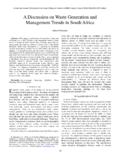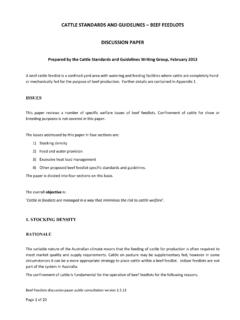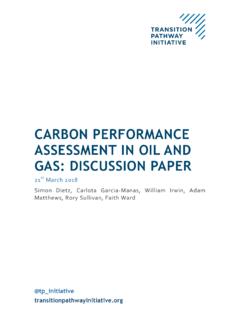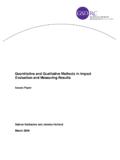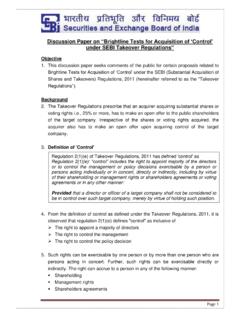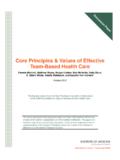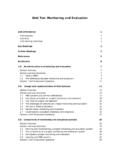Transcription of DISCUSSION ON BEST PRACTICES FOR RISK …
1 142 Informatica Economic vol. 15, n o. 2/2011 On best PRACTICES for Risk management in Complex Projects Dan BEN A1, 2, Ioan Marius PODEAN1, 2, Cristian MIRCEAN1 1 Siemens AG., Corporate Technology, Project and Risk management , Munich, Germany 2 Faculty of Economics and Business Administration, Babe -Bolyai University of Cluj-Napoca, Romania Risk management shall be proactive. This is one of the key preliminaries to cope with the challenges of complex projects. An overarching and consistent view on project risks and uncertainties is necessary to follow a holistic approach in project risk management .
2 Uncertainty is inevitable since projects are unique and temporary undertakings based on assumptions and constraints, delivering project results to multiple stakeholders with different requirements. Project management can be seen as an attempt to control this uncertain environment, through the use of structured and disciplined techniques such as estimating, planning, cost control, task allocation, earned value analysis, monitoring, and review meetings. Each of these elements of project management has a role in defining or controlling inherent variability in projects.
3 Project risk management provides approaches by which uncertainty can be understood, assessed, and managed within projects. A number of associations ( , Project management Institute PMI , International Project management Association IPMA,or Network of Nordic Project management Associations - NORDNET) work constantly in acquiring, improving, and standardizing best PRACTICES in project on the industrial practice, this paper outlines strategies to identify, prioritize, and mitigate risks for achievement of project or organizational objectives.
4 Keywords: Project management , Risk management , best PRACTICES of management , Standardization of management , Maturity of Organizations Introduction As integral part of project management , effective risk management is a critical success factor for delivering projects in predefined cost, time, and quality. Project risk management provides benefits when it is implemented according to good practice principles and with organizational commitment to taking the decisions and performing actions in an open and unbiased manner.
5 Starting with the definition, risksare uncertain events which when occur have negative effect on at least one project goal , time, costs, contents or quality. Contrasting, the positive variability is desired and is called opportunity. Despite the simple explanation, the project managers often include into risksarea the problems and technical or organizational issues. It is well to note: the risks are potential events in future which did not occur yet (while problems are risks that occurred). risks are characterized by probability, always less than 100%; and impact measured in changes of the objectives.
6 risks may be measured in costs (monetary risks ) in time (delay risks for time management ) or quality (usually affecting contracts thru monetary cost of improvement). Interests in risk management are not new and in the late 90s, authors state that risk management was a significant step in most organizations [7] [9]. While risk management is a critical activity in construction project management , existing industry PRACTICES involve tools like risk registers, risk management spreadsheets, brain storming sessions etc.
7 As a result, many risks remain unidentified, and proper risk management becomes impossible [4] . Useful acknowledged techniques for identifying risks , as presented in [9] , include brainstorming and SWOT analysis (Strengths, Weaknesses, Opportunities and Threats). Whereas external consultants may be used, the effectiveness of the systems will 1 Informatica Economic vol. 15, n o. 2/2011 143 depend on a comprehensive understanding of how the business operates in practice, and any standard solutions should be approached with caution.
8 2 Role of risk management in project lifecycle In a multidimensional space of the project objectives (or expectations), during project phases and based on the stakeholders evaluation, the project passes a trajectory. Risk may be described as the distance between the objectives (or stakeholder expectations) and the current situation (or the perceived current situation) in the upper described multidimensional space. For this reason, targets require to be well defined, well known, and well documented for project.
9 Fig. 1. Processes in the sales (acquisition) phase of projects In the sales phase of projects, each large project crosses several phases that are relevant in terms of project risk management . The team of project sales (called sometimes acquisition) is distinct to the team of execution. Some complex sales create a project-like team with a designated project manager of sales. The concept of risk management has become important and central to corporate management andessential to successful project management in complex setting.
10 Risk management should be applied at major project milestones and hence be included in project plans and operational documents becoming integral part of every aspect of managing the project, in every phase and in every process of the financial impact it may bring, risk management shall be performed from the acquisition phase ( , project sales) so that the organization may find easier decisions on the project path. An initial risk assessment at acquisition phase improves correctness of the earnings before interest and taxes(or operating profit) calculations and adjusts expectation of the project itself.



